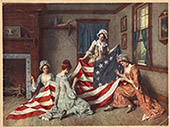Libraries, University of Nebraska-Lincoln
Document Type
Archival Material
Date of this Version
1734
Abstract
The early stirrings of the Great Awakening were intensified by Edwards’ famous sermon A Divine and Supernatural Light, Immediately Imparted to the Soul by the Spirit of God (1734). Through a fascinating process of canceling out his opponents’ positions, Edwards clearly defines the workings of God’s grace in the human soul. He distinguishes between “Common Grace” (intrinsic to virtually all unregenerate), which acts upon the mind of natural man and assists the faculties of the soul in their natural course; and “Special Grace” (intrinsic to true saints only), which acts in the human heart and unites with the mind of the saint as a new supernatural principle of life and action that restores human faculties to their proper place. God’s spiritual light therefore does not consist of making impressions on the Imagination nor does it teach any new dogmas; it only gives a due apprehension of God’s beauty. Hence a saint with indwelling grace does not merely believe rationally that God is glorious, but has a due sense of God’s glory in his own heart. Whereas the head can merely sustain a speculative or notional knowledge of beauty, the heart delights in the idea of it, and the will prompted by the affections for the highest good embraces the virtuous act. In Edwards’ illustration, the unregenerate can rationally attain a sense of God’s beauty, but only the sanctified can attain full conviction and immediate evidence of God’s grace: one can have a rational sense of the sweetness of honey, but the true sense of its taste can only be attained through experience. Edwards’ distinction is echoed in what Samuel Taylor Coleridge would call primary and secondary beauty.
Included in
American Literature Commons, American Popular Culture Commons, Religious Thought, Theology and Philosophy of Religion Commons



Comments
A SERMON Preach’d at Northampton, [Mass.], And Published at the Desire of some of the Hearers. Boston: S. Kneeland & T. Green. 1734